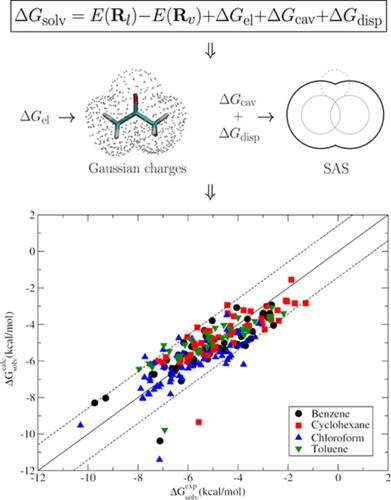当前位置:
X-MOL 学术
›
J. Comput. Chem.
›
论文详情
Our official English website, www.x-mol.net, welcomes your feedback! (Note: you will need to create a separate account there.)
Effect of the Solute Cavity on the Solvation Energy and its Derivatives within the Framework of the Gaussian Charge Scheme
Journal of Computational Chemistry ( IF 3 ) Pub Date : 2019-12-30 , DOI: 10.1002/jcc.26139 Miquel Garcia-Ratés 1 , Frank Neese 1
Journal of Computational Chemistry ( IF 3 ) Pub Date : 2019-12-30 , DOI: 10.1002/jcc.26139 Miquel Garcia-Ratés 1 , Frank Neese 1
Affiliation

|
The treatment of the solvation charges using Gaussian functions in the polarizable continuum model results in a smooth potential energy surface. These charges are placed on top of the surface of the solute cavity. In this article, we study the effect of the solute cavity (van der Waals‐type or solvent‐excluded surface‐type) using the Gaussian charge scheme within the framework of the conductor‐like polarizable continuum model on (a) the accuracy and computational cost of the self‐consistent field (SCF) energy and its gradient and on (b) the calculation of free energies of solvation. For that purpose, we have considered a large set of systems ranging from few atoms to more than 200 atoms in different solvents. Our results at the DFT level using the B3LYP functional and the def2‐TZVP basis set show that the choice of the solute cavity does neither affect the accuracy nor the cost of calculations for small systems (< 100 atoms). For larger systems, the use of a vdW‐type cavity is recommended, as it prevents small oscillations in the gradient (present when using a SES‐type cavity), which affect the convergence of the SCF energy gradient. Regarding the free energies of solvation, we consider a solvent‐dependent probe sphere to construct the solvent‐accessible surface area required to calculate the nonelectrostatic contribution to the free energy of solvation. For this part, our results for a large set of organic molecules in different solvents agree with available experimental data with an accuracy lower than 1 kcal/mol for both polar and nonpolar solvents.
中文翻译:

高斯电荷方案框架内溶质空腔对溶剂化能及其导数的影响
在可极化连续介质模型中使用高斯函数处理溶剂化电荷会产生平滑的势能表面。这些电荷位于溶质腔表面的顶部。在本文中,我们在类导体极化连续介质模型的框架内使用高斯电荷方案研究溶质腔(范德华型或溶剂排除表面型)对(a)精度和计算的影响自洽场 (SCF) 能量及其梯度的成本以及 (b) 溶剂化自由能的计算。为此,我们考虑了大量系统,范围从几个原子到不同溶剂中的 200 多个原子。我们使用 B3LYP 泛函和 def2-TZVP 基组在 DFT 级别的结果表明,溶质腔的选择既不会影响小型系统(< 100 个原子)的计算精度,也不会影响计算成本。对于较大的系统,建议使用 vdW 型腔,因为它可以防止梯度中的小振荡(使用 SES 型腔时出现),这会影响 SCF 能量梯度的收敛。关于溶剂化的自由能,我们考虑了一个依赖于溶剂的探针球来构建计算溶剂化自由能的非静电贡献所需的溶剂可及表面积。对于这部分,
更新日期:2019-12-30
中文翻译:

高斯电荷方案框架内溶质空腔对溶剂化能及其导数的影响
在可极化连续介质模型中使用高斯函数处理溶剂化电荷会产生平滑的势能表面。这些电荷位于溶质腔表面的顶部。在本文中,我们在类导体极化连续介质模型的框架内使用高斯电荷方案研究溶质腔(范德华型或溶剂排除表面型)对(a)精度和计算的影响自洽场 (SCF) 能量及其梯度的成本以及 (b) 溶剂化自由能的计算。为此,我们考虑了大量系统,范围从几个原子到不同溶剂中的 200 多个原子。我们使用 B3LYP 泛函和 def2-TZVP 基组在 DFT 级别的结果表明,溶质腔的选择既不会影响小型系统(< 100 个原子)的计算精度,也不会影响计算成本。对于较大的系统,建议使用 vdW 型腔,因为它可以防止梯度中的小振荡(使用 SES 型腔时出现),这会影响 SCF 能量梯度的收敛。关于溶剂化的自由能,我们考虑了一个依赖于溶剂的探针球来构建计算溶剂化自由能的非静电贡献所需的溶剂可及表面积。对于这部分,



























 京公网安备 11010802027423号
京公网安备 11010802027423号